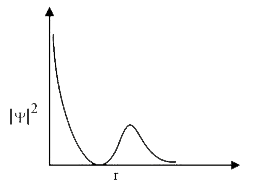Describe the principle of an atom bomb. What is the criticalmass of ?
Step-by-Step Solution:
Step 1: Understanding Nuclear Fission
- Nuclear fission is the process in which the nucleus of an atom splits into two or more smaller nuclei, along with the release of energy. This process can occur spontaneously or can be induced by bombarding the nucleus with neutrons.
Step 2: Principle of an Atom Bomb
- An atom bomb operates on the principle of uncontrolled nuclear fission chain reactions. In this process, a fissile material, such as Uranium-235 (U-235) or Plutonium-239 (Pu-239), undergoes fission when it absorbs a neutron.
Step 3: Chain Reaction
- When a U-235 nucleus absorbs a neutron, it becomes unstable and splits into two smaller nuclei, releasing additional neutrons and a significant amount of energy. The released neutrons can then strike other U-235 nuclei, causing them to undergo fission as well. This leads to a rapid, uncontrolled chain reaction.
Step 4: Critical Mass
- The critical mass is the minimum amount of fissile material needed to sustain a chain reaction. If the mass of the fissile material is below this critical mass, the reaction will fizzle out. If it exceeds this mass, the reaction becomes self-sustaining and releases a tremendous amount of energy.
Step 5: Critical Mass of Uranium-235
- The critical mass of Uranium-235 varies based on several factors, including the shape and purity of the material. Generally, the critical mass for U-235 is estimated to be between 1 kg to 100 kg.
Summary:
- The principle of an atom bomb is based on uncontrolled nuclear fission chain reactions, where the critical mass of Uranium-235 is typically between 1 kg and 100 kg.
---
- Nuclear fission is the process in which the nucleus of an atom splits into two or more smaller nuclei, along with the release of energy. This process can occur spontaneously or can be induced by bombarding the nucleus with neutrons.
- An atom bomb operates on the principle of uncontrolled nuclear fission chain reactions. In this process, a fissile material, such as Uranium-235 (U-235) or Plutonium-239 (Pu-239), undergoes fission when it absorbs a neutron.
- When a U-235 nucleus absorbs a neutron, it becomes unstable and splits into two smaller nuclei, releasing additional neutrons and a significant amount of energy. The released neutrons can then strike other U-235 nuclei, causing them to undergo fission as well. This leads to a rapid, uncontrolled chain reaction.
- The critical mass is the minimum amount of fissile material needed to sustain a chain reaction. If the mass of the fissile material is below this critical mass, the reaction will fizzle out. If it exceeds this mass, the reaction becomes self-sustaining and releases a tremendous amount of energy.
- The critical mass of Uranium-235 varies based on several factors, including the shape and purity of the material. Generally, the critical mass for U-235 is estimated to be between 1 kg to 100 kg.
- The principle of an atom bomb is based on uncontrolled nuclear fission chain reactions, where the critical mass of Uranium-235 is typically between 1 kg and 100 kg.
Topper's Solved these Questions
- NCERT BASED EXERCISEBook:CENGAGE CHEMISTRY ENGLISHChapter:NCERT BASED EXERCISEExercise:Surface Chemistry (In-Text Question)
Explore 8 Videos
- GRIGNARD REAGENTS AND ORGANOMETALLIC REAGENTSBook:CENGAGE CHEMISTRY ENGLISHChapter:GRIGNARD REAGENTS AND ORGANOMETALLIC REAGENTSExercise:Exercises Archives (Linked Comprehension)
Explore 1 Video
- NUCLEAR CHEMISTRYBook:CENGAGE CHEMISTRY ENGLISHChapter:NUCLEAR CHEMISTRYExercise:Archives Subjective
Explore 13 Videos
Similar Questions
The graph for an orbital between |φ|2 and r(radial distance) is shown below. The sum of principle quantum number, azimuthal, quantum number and magnetic quantum number of this orbital is ____________.

View SolutionDescribe principle and working of the periscope.
View SolutionA uranium U235 nucleus liberates an energy of 200 MeV in the process of fission. 1.5 kg of uranium take part in the reaction during the explosion of a uranium bomb. What is the mass of an equivalent TNT bomb, if the heating capacity of TNT is 4.1 MJ/kg?
View SolutionThe atomic bomb uses the principle of ……………… .
View SolutionThe first atomic bomb was thrown over
View SolutionWhich of the following element is an isodiapher of .92U235?
View SolutionIn an atom bomb, the energy is released because of the.
View SolutionCalculate the number of neutrons in the remaining atoms after the emission of an alpha particle from .92U238 atom.
View SolutionA 1000 MW fission reactor consumes half of its fuel in 5.00yr. How much .92U235 did it contain initially? Assume that the reactor operates 80% of the time and that all the energy generated arises form the fission of .92U235 and that this nuclide is consumed by the fission process.
View Solutionfind the amount of energy produced in jaoules due to fission of 1 g of .92U235 assuming that 0.1% of mass is transormed into enengy ,Atomic mass of .92U235=235 amu , Avogodro number NA=6.023×1023. Given that the energy released per fission is 200 MeV.
View Solution